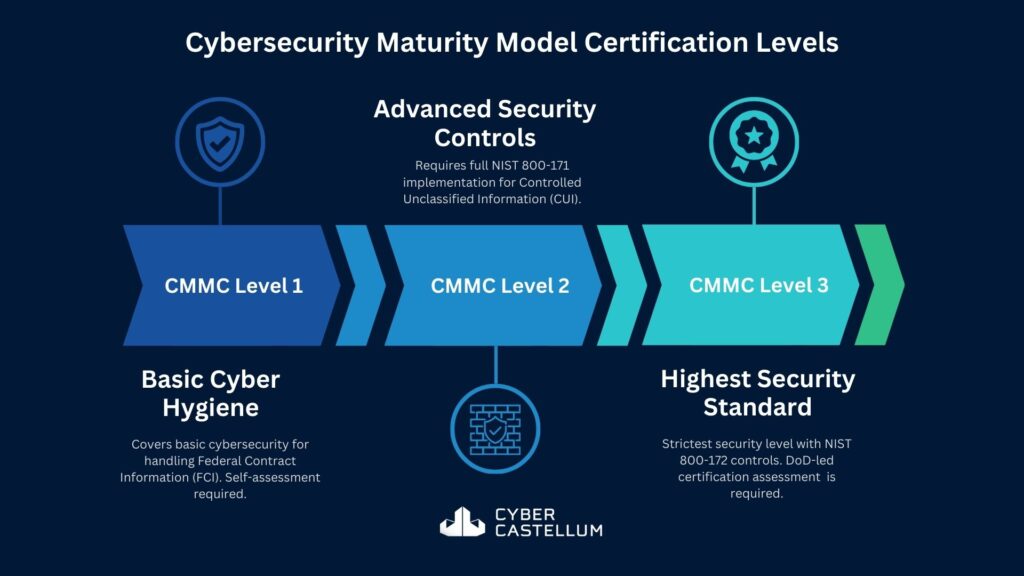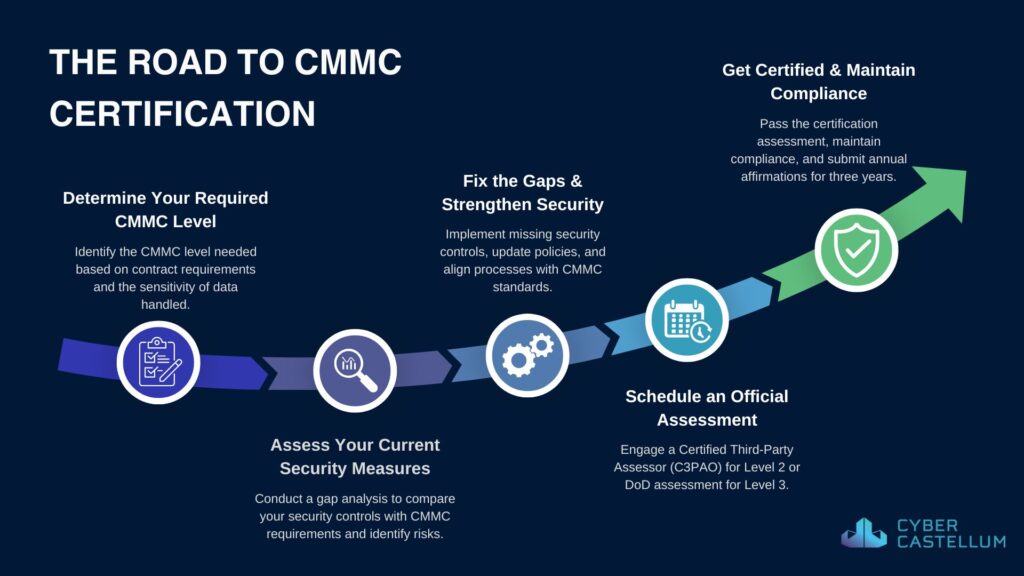Cybersecurity Consulting Firm – Cyber Castellum

Cyber threats are on the rise, and the U.S. Department of Defense (DoD) is taking action to protect sensitive data. That’s where the Cybersecurity Maturity Model Certification (CMMC) comes in; the current version is also referred to as CMMC 2.0. If you’re a defense contractor, understanding CMMC final rule is essential—not just for compliance, but for securing your business and the nation’s supply chain. Let’s break down what is the CMMC framework, why it was created, what are three CMMC compliance levels, who needs to be CMMC certified, and how you can get certified without all the headaches.
So, what is CMMC? And who needs CMMC certification?
For years, the DoD relied on the honor system, asking contractors to follow CMMC cybersecurity guidelines laid out in Defense Federal Acquisition Regulation Supplement (DFARS) and NIST Special Publication, SP 800-171. The problem? Many companies weren’t actually implementing the security measures they attested to. As cyberattacks on government contractors became more frequent and damaging, it became clear that a more enforceable system was needed. That’s where CMMC comes in—a structured framework that requires actual proof of CMMC 2.0 compliance, rather than just a promise.
CMMC Timeline
If you have been following the CMMC news, you may know that the CMMC proposed rule was initially released in 2020. After receiving comments and feedback, the proposed rule was updated in 2023. The final CMMC 2.0 rule was published in the Federal Register in October, 2024 with the effective date for the first phase of CMMC 2.0 to begin in December, 2024.
The phased roll out of CMMC as a contractual requirement is expected to begin in 2025. However, full implementation across all contracts will continue until 2028 when all contracts will have CMMC requirements. Implementing CMMC level 2 controls can take months. To meet CMMC compliance deadlines, take action now so that you don’t miss out on any DoD contract opportunities.
CMMC Levels Explained
CMMC isn’t a one-size-fits-all program. Instead, there are three CMMC levels, allowing companies to certify at the level that matches their risk profile and the type of data they handle:

- CMMC Level 1 – This is the entry-level certification, covering basic cybersecurity practices. Companies handling Federal Contract Information (FCI) need to ensure 15 CMMC Level 1 requirements are met. A self-assessment and annual attestation is required.
- CMMC Level 2 – This level is for companies dealing with Controlled Unclassified Information (CUI). It requires full implementation of 110 security controls described in NIST SP 800-171 that have to be validated by a Certified Third-Party Assessment Organization (C3PAO).
- CMMC Level 3 – This is the highest level, designed for contractors handling highly sensitive data. It builds on Level 2 but incorporates even stricter security controls from NIST 800-172. A DoD-led certification assessment is required.
How to Get CMMC certification?
The road to CMMC certification might seem daunting, but breaking it into steps makes it manageable:

- Determine Your Required CMMC Level – First, figure out what type of data you handle and which CMMC 2.0 requirements apply to you. The CMMC level required for a contractor is typically specified within the contract or request for proposal (RFP), based on the sensitivity of the Information the contractor will handle during the project.
- Assess Your Current Security Measures – Conduct a gap analysis to see where you stand compared to CMMC requirements. This could be in the form or a formal CMMC readiness assessment. A self-assessment against CMMC level 1 checklist may be sufficient for some DoD contractors. For others, a third-party certification assessment may be needed against Level 2 requirements. For contractors requiring Level 3, certification assessment has to be conducted by CMMC assessors within DoD. However, remember that even to navigate the details of a Level 1 or Level 2 self-assessment, you might need guidance from CMMC consulting partners you can trust. You should balance CMMC certification cost against too much reliance on your existing technology provider(s).
- Fix the Gaps – After conducting an appropriate level of CMMC assessment, you may have to implement missing security controls, update policies, and ensure your processes align with CMMC standards. A CMMC consulting partner can provide CMMC compliance services to ensure you are following industry best practices and any resources spent on addressing gaps in fact get you the expected results especially if you need certification against CMMC level 2 requirements.
- Schedule an Assessment – If you need Level 2 certification, you’ll need one of the Certified Third-Party Assessor Organizations, also referred to as a C3PAO, to conduct a CMMC assessment. For Level 3, the assessment is led by DoD. Again, working with a consultant in the earlier stages can pay off here since the consultant, familiar with your environment, can help you gather evidence and ensure you are not missing anything needed to meet CMMC compliance requirements.
- Get Certified – Once you pass the certification assessment, your certification is valid for three years. During this time, you will need to maintain compliance with CMMC rules and provide an annual affirmation.
What are the CMMC requirements? And when to work with CMMC Consultants?
At CMMC level 1, contractors are expected to meet the 15 requirements of Federal Acquisition Regulation (FAR) clause 52.204-21 including Access Controls, Media Protection, Physical Protection, System and Communication Protections, and System and Information Integrity. At CMMC level 2, contractors need to meet the practices within NIST 800-171.
Let’s be honest—CMMC isn’t easy. The CMMC certification requirements are onerous, the CMMC assessment process is rigorous, and failing an assessment can delay your ability to bid on DoD contracts. That’s why many companies bring in cybersecurity consultants to guide them through the process. A good CMMC compliance consultant can help you navigate the CMMC 2.0 Cybersecurity Framework and support you in the following aspects:
- Identifying weak spots in your defenses to strengthen your CMMC security posture and prepare you for compliance with CMMC.
- Creating a clear roadmap to compliance that outlines the steps you and/or your external service providers may need to take.
- Preparing for your CMMC audit by collecting all the needed evidence in an efficient and clear manner.
Final Thoughts
CMMC isn’t just another bureaucratic hoop to jump through—it’s a necessary step toward protecting national security and your business from cyber threats. With certification becoming a requirement for most DoD contracts, now is the time to get ahead. Whether you’re starting from scratch or need help fine-tuning your security program, leveraging CMMC compliance consulting can make all the difference.
If you’re preparing for CMMC, don’t go it alone. Reach out to Cyber Castellum to help you navigate the process smoothly and successfully.
